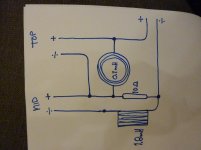Hi
I have made a crossover with 2 inductors and 1 resistor.
Using Scanspeak 6600 and Seas Excel 6.5".
It sounds realy great, the tweeter is so smood.
I know the Excel have a peak at around 5k Hz but this is no problem in my ears. What do you people think of the filter?
The 0.12uH is 12 awg and the 1.8uH is 16 awg.
I have made a crossover with 2 inductors and 1 resistor.
Using Scanspeak 6600 and Seas Excel 6.5".
It sounds realy great, the tweeter is so smood.
I know the Excel have a peak at around 5k Hz but this is no problem in my ears. What do you people think of the filter?
The 0.12uH is 12 awg and the 1.8uH is 16 awg.
Attachments
This is like ar-sxo right?
AR-SXO - Acoustic Reality - Designed and built in Denmark
AR-SXO - Acoustic Reality - Designed and built in Denmark
An externally hosted image should be here but it was not working when we last tested it.
Another version of that is the xo design employed years ago by Sonus Faber in their highly regarded and very expensive Extrema speaker.
The SFE design inspired my 'Intimates' speakers. Introducing the "INTIMATES" (high WAF & quality sound)
I solved the resistor power dissipation issue using my vent. Visit the link for details. Strangely though, efficiency ended up about 84 dB @ 2.83V - not much different than many commercial high end 2-way mini-monitors.
The SFE design inspired my 'Intimates' speakers. Introducing the "INTIMATES" (high WAF & quality sound)
I solved the resistor power dissipation issue using my vent. Visit the link for details. Strangely though, efficiency ended up about 84 dB @ 2.83V - not much different than many commercial high end 2-way mini-monitors.
speakerdoctor, the SFE crossover was what inspire me, the sine-cap.
Have a friend that made a pair of replica SFE in the late 90th.
With the right tweeter and bass. They were extrem heavy driven.
Only big Mark Levinson and Dynamic Pricusion made them play at there full.
Some hade to do with the resistor(s) to the tweeter in the crossover.
Try to eliminate this with the new filter. Or am I way out? ( out biking as we say here up in the north )
Have a friend that made a pair of replica SFE in the late 90th.
With the right tweeter and bass. They were extrem heavy driven.
Only big Mark Levinson and Dynamic Pricusion made them play at there full.
Some hade to do with the resistor(s) to the tweeter in the crossover.
Try to eliminate this with the new filter. Or am I way out? ( out biking as we say here up in the north )
Try to eliminate this with the new filter. Or am I way out? ( out biking as we say here up in the north )
You eliminate your resistor, and your amp will likely die.
Wolf
Why?You eliminate your resistor, and your amp will likely die.
Wolf
I mean not for this particular example, for this idea in general, why couldn't you just use inductors in an xo?
Why?
I mean not for this particular example, for this idea in general, why couldn't you just use inductors in an xo?
Maybe Post #6 answers your question.
Why?
I mean not for this particular example, for this idea in general, why couldn't you just use inductors in an xo?
To the lowest of frequencies, the coil is a dead short, without some resistance between the source and ground, that's exactly what you have, a dead short. That is how the coil, which is after all just a length of wire, works.
There must be some resistance in the form of an actual resistor, or in the form of the other drivers (in this case the mid-bass) providing a path to ground.
If we use the Schematic of AR speaker shown in Post #3, the first coil (L1) is a short past the tweeter feeding signal to the woofer. However, the woofer circuit has a series coil to block all high frequencies. Where do the high frequencies have to go once they leave the tweeter? Without a resistor to ground, they have no where to go and therefore simply don't go.
The resistor provides an alternate path to ground for the high frequencies that are blocked from passing through the woofer path to ground.
However, in a more general sense, a parallel coil is a short.
Steve/bluewizard
- Status
- This old topic is closed. If you want to reopen this topic, contact a moderator using the "Report Post" button.
- Home
- Loudspeakers
- Multi-Way
- Two way crossover with no capacitors
